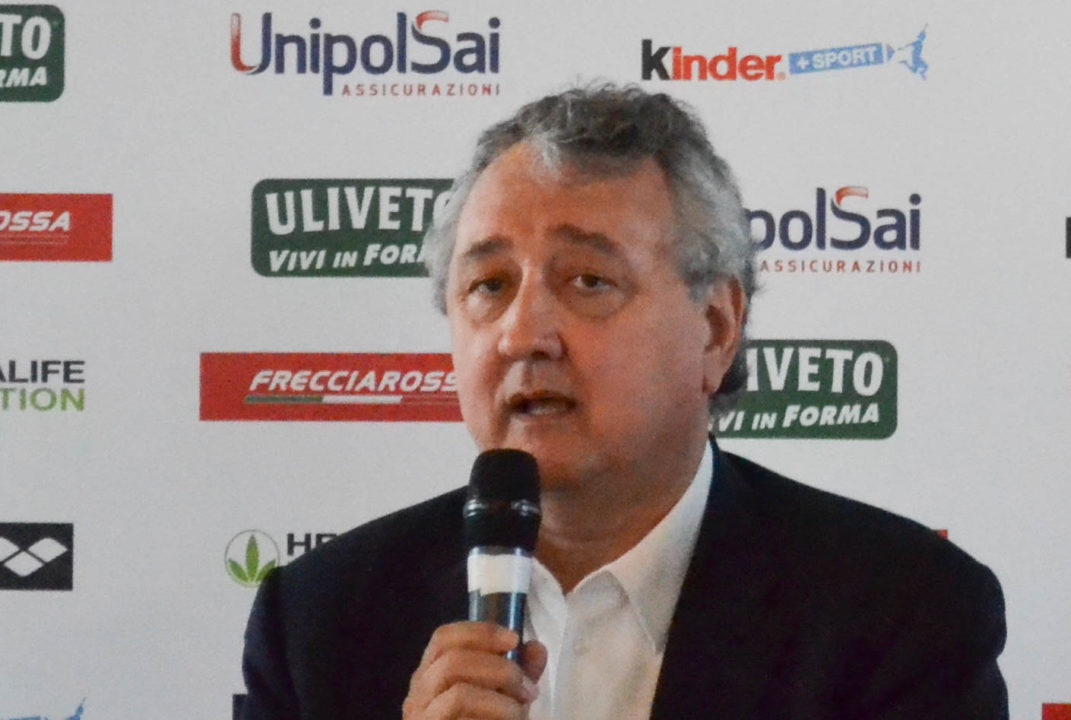Originally reported for SwimSwam Italia by Giusy Cisale.
Just days before the 2019 FINA World Championships began in Gwangju, president of the Italian Swimming Federation and LEN Paolo Barelli gave an interview to the Italian newspaper Il Corriere dello Sport on Worlds and the state of professional swimming.
According to Barelli, the Korean World Championships represents an opportunity for Italy to improve. The Italian national team therefore goes to Gwangju to do its best; there is the awareness that in any part of the world and at any time a new champion can suddenly emerge. The growth of the Italian movement is confirmed by recent international results, but Barelli adds: “It is right to think that the other countries have done the same.”
Barelli continues: “We have always wanted to pursue all the disciplines. Swimming, water polo, free water, diving, synchronized. In some disciplines there is a generational change, I am thinking of diving without [Tania] Cagnotto and [Francesca] Dallapè, where, in any case we are doing well again. In open water, with [Gregorio] Paltrinieri and [Domenico] Acerenza, we are expanding the team.”
Barelli speaks on pro swimming opportunities
The final passage of the interview is perhaps the most interesting: Barelli gives his take on the new International Swimming League and FINA Champions Series.
He is asked is the following:
Where does world swimming go? New circuits have been born, such as the International Swimming League and FINA has also expanded the calendar of events.
Barelli replies:
“We must be careful. We are not tennis. A swimmer cannot replicate a 400 freestyle — just to give an example — 20 times in a high-level season. Good news, but do not overdo it. It is important to find a balance point and FINA should give greater autonomy to continental movements.”
Of significance, Barelli is the president of one of those continental movements: the European LEN organization.
Note: The 2019 season of the International Swimming League includes a stage in Italy, in Naples, on 12 and 13 October 2019.

Does anyone have insight on track and field and how their pro circuit works and performance?
I know there is more money due to sponsorships / a shoe campy can sponsor someone for their performance shoe – average viewer / runner won’t buy the track shoe but may get a pair of running shoes or just know of the brand get the shoe for every day shoes.
Where I can see a swimmer wearing an arena suit – – but I don’t think I’m buying a pair of beach shorts as a result.
At the end of the day, while people love to see great times, they also love to see great races. I think if it works out, this is something the ISL could really harness.
Tennis is bad for ocular muscle overload whereas swimmers move much slower.
Unfortunately, we are not tennis.
I think his point is that tennis has an advantage because a fan can’t easily see the difference between a player’s best performance and their mid season 5% off performance. In swimming the time is right there on the scoreboard and it’s just less exciting to see no best times and no records. Casual fans are spoiled by only having watched the Olympics. They expect someone out front to be at or ahead of that world record line.
They should use supersuits in the ISL.
I see no reason that swimmers can’t swim fast consistently. Sjostrom and Hossju and Ledecky have managed it, across a range of different events.
Competition on these pro circuits need to be viewed as extensions of practice/training as opposed to taper meets.
No they aren’t going to break world records every fortnight, but there is no reason they couldn’t be within 3% or so of their best times many times per season.
If these athletes want to be paid better, racing often and producing quality content for fans IS the key. This idea swimmers and coaches have that they should only swim fast once or twice a year is a big obstacle for these professional swimming movements to overcome.
Totally agree. It has two components to it: mental and physical(training). Swimmers and coach will need to adapt for the changing world.
I wonder if this movement towards more frequent high-level racing will result in more USRPT (for those swimming 200s and under of course). MA’s program seems made for this kind of set-up.
I’d be very interested to see what Hosszu was doing specifically. Her world cups were/are incredible
Well she’s in the gym everyday according to instagram, as is Sarah S, so perhaps they’re doing different types of workouts/cross training that keeps them fresh when they are in the pool
Amen. I love the idea of the FINA series and more meets like Mare Nostrum coming out with super fast times “in season”..i think the idea of “in season” altogether should just kinda be nixed, and rather it be a ton of really fast, exciting swims, culminating with one huge, mind blowing swim at worlds or the olympics. it’s more just the size of the stage that is the difference